Holding a pickerel properly is essential for both the angler’s safety and the well-being of the fish. Pickerel, known for their sharp teeth and thrashing behavior, require careful handling to avoid injury to both parties. Whether you’re practicing catch and release or planning to keep your catch, knowing how to hold a pickerel securely and safely is crucial.
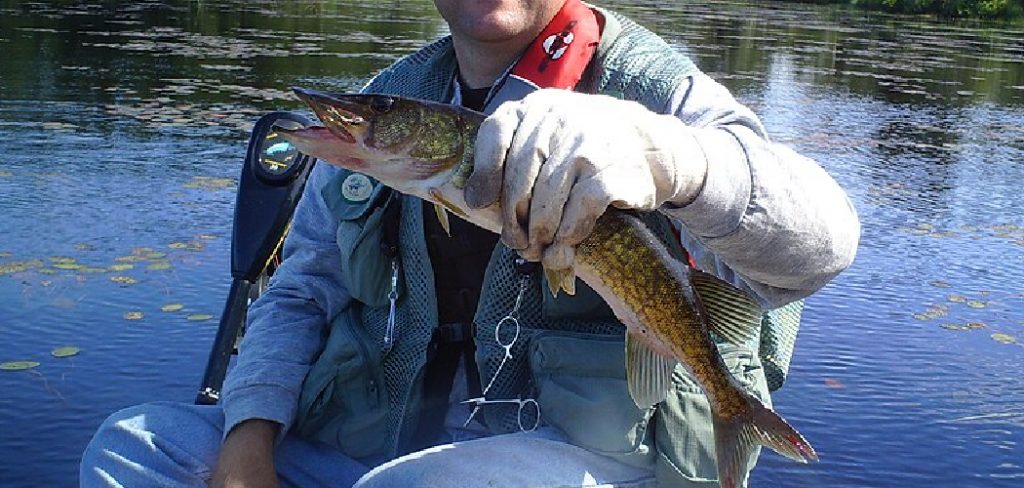
In this guide, we’ll explore the best practices for holding pickerel, offering tips and techniques to help anglers handle these feisty predators with confidence. From avoiding the teeth to supporting the fish correctly, mastering the art of holding a pickerel will not only enhance your fishing experience but also contribute to the conservation of these prized freshwater species.
Significance of Proper Pickerel Handling
Proper handling of pickerel is vital for several reasons, often transcending the immediate concerns of angler safety and fish welfare. Firstly, respectful and careful handling demonstrates an angler’s commitment to conservation and sustainable fishing practices. By ensuring that the pickerel is subjected to minimal stress and injury, anglers can significantly increase the chances of survival for released fish, contributing to the health and balance of aquatic ecosystems.
Secondly, understanding how to handle pickerel correctly reflects on the ethical fishing practices that are crucial for maintaining the sport’s integrity and ensuring its future. Lastly, for those intending to keep their catch, proper handling can affect the quality of the fish as table fare, making it a crucial aspect of the fishing experience from catch to kitchen.
Understanding Pickerel Anatomy
To handle a pickerel effectively, it’s crucial to have a basic understanding of the fish’s anatomy, especially the parts that can pose risks to anglers. Pickerels are members of the pike family and share many characteristics with their larger relatives, including their elongated bodies, pointy snouts, and most notably, their sharp teeth. These teeth are not only capable of inflicting significant cuts but are a crucial part of how pickerels grasp and immobilize their prey.
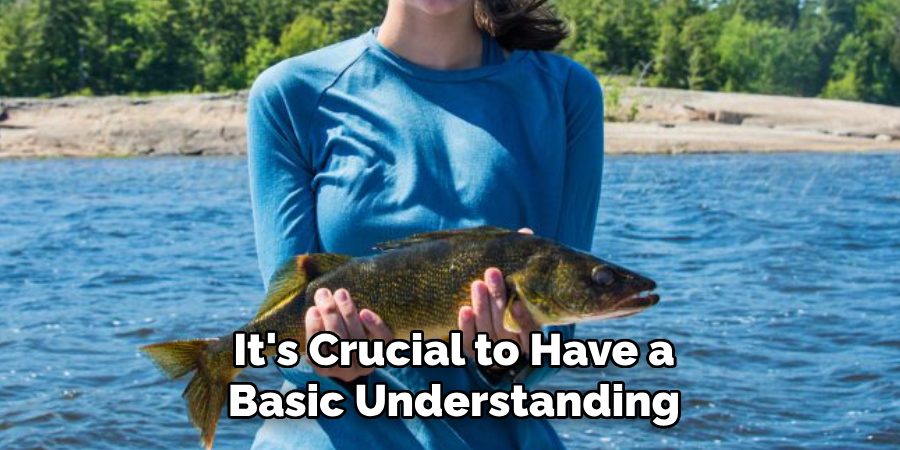
Additionally, pickerels have a slimy coating on their skin, protecting them from parasites and injuries but making them more challenging to grip securely. Their dorsal and ventral sides are relatively smooth, but care should be taken to avoid the gill covers, which can be sharp and may injure both the fish and the handler. Understanding these aspects of pickerel anatomy is the first step in ensuring that you can hold them safely, minimizing the risk of injury to both the fish and yourself.
Identification of Key Features Relevant to Handling
For effective and safe handling of pickerel, identifying key features of their anatomy that are relevant to how they should be held is crucial. Key features to focus on include:
- Mouth and Teeth: The mouth of the pickerel is its most distinctive and hazardous feature when handling. Equipped with numerous sharp teeth designed for grasping prey, the mouth area, especially the inside, poses a risk to handlers. Avoid putting fingers near the mouth to prevent bites.
- Gill Plates: While the gills themselves are delicate and should not be touched to avoid harming the fish, the gill plates or covers can be used as a point of grip. However, proceed with caution as the edges can be sharp. Lifting a pickerel by sliding fingers behind the gill plates allows for control of the head while avoiding the dangerous mouth area.
- Body and Coating: The body of the pickerel is long, slim, and covered in a slippery mucous coating. This slimy layer serves as protection for the fish against infections and parasites. When handling pickerel, ensure a firm yet gentle grip to avoid removing this protective slime. Wetting your hands before handling can minimize damage to the slime layer.
- Dorsal and Ventral Fins: These fins are relatively safe to touch compared to other parts of the pickerel but are essential for determining how to support the fish’s weight properly. Avoid pressing down on these fins or handling them harshly as it can cause discomfort or injury to the fish.
Recognizing these features and understanding their relevance in handling can significantly improve the safety and welfare of both the angler and the pickerel during the catch and release process or when preparing it for consumption.
Behavioral Tendencies of Caught Pickerel
Pickerel display distinct behavioral patterns and tendencies when caught that anglers should be mindful of, to ensure safe and effective handling. These behaviors are primarily defense mechanisms, evolved to help the fish escape from predators, including humans. Understanding these responses can greatly assist in managing the situation when a pickerel is on the line or in hand.
- Thrashing: Upon being caught, pickerel are known for their vigorous thrashing behavior. This sudden and forceful movement is an attempt to escape, which can pose a risk of injury to the angler if not prepared. The thrashing can also increase the chance of the fish injuring itself or shaking the hook loose.
- Attempting to Bite: Pickerel, armed with sharp teeth, might attempt to bite when handled. This behavior is more common if the fish feels threatened or cornered. Anglers should be particularly cautious to avoid placing their hands near the pickerel’s mouth.
- Slipperiness: The mucous coating that covers the pickerel’s body makes it particularly slippery, a natural defense mechanism that helps it escape from predators’ grips. This slipperiness can be surprising to anglers, especially those new to fishing for pickerel, and can lead to dropping the fish or an inability to maintain a secure hold.
- Playing Dead: Some pickerel may exhibit a behavior akin to playing dead once out of the water or when they feel they cannot escape. It’s crucial for anglers to be aware that this is a temporary state, and the fish can resume thrashing once it perceives an opportunity to escape.
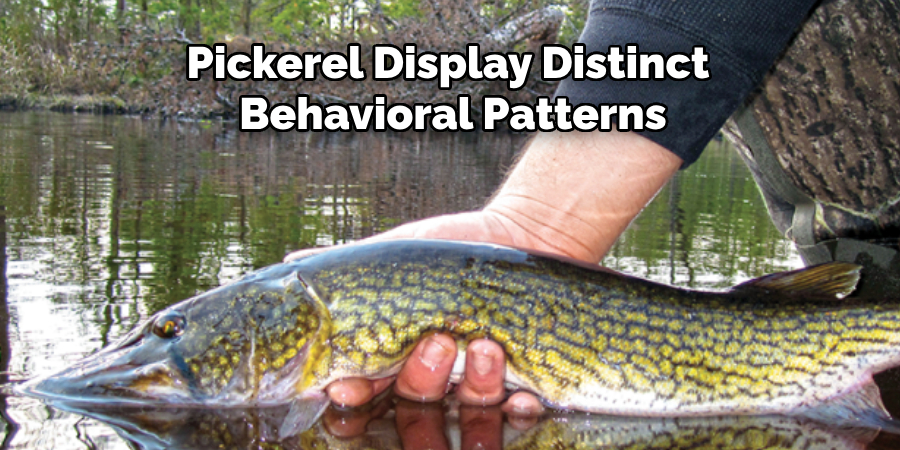
Understanding these behaviors is crucial for both the safety of the angler and the welfare of the pickerel. By anticipating these tendencies, anglers can prepare themselves to handle the fish safely and efficiently, minimizing stress and injury to the fish and ensuring a more humane fishing experience.
10 Methods How to Hold a Pickerel
1. Use Pliers or Forceps to Control the Jaw:
When handling pickerel, always use pliers or forceps to control the fish’s jaw. Pickerel have sharp teeth that can easily injure an angler’s fingers if not properly restrained. Grip the fish’s lower jaw firmly with the pliers while supporting its body with your other hand. This will prevent the fish from thrashing and causing injury to itself or to you.
If you do not have pliers or forceps, you can also use a wet cloth or rag to grip the jaw. However, make sure that the cloth is wet so that you can get a good grip on the slippery fish.
It is important to control the jaw of pickerel because they have a strong bite reflex and can cause serious damage if not handled properly. By controlling the jaw, you are also able to remove the hook safely and efficiently.
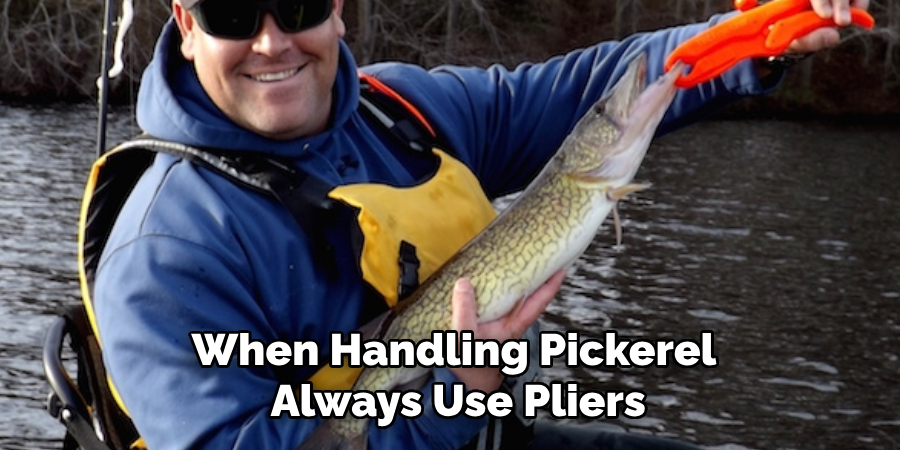
2. Support the Body with Both Hands:
Support the pickerel’s body with both hands to minimize stress and prevent injury. Hold the fish horizontally, with one hand under the belly and the other supporting near the tail. Avoid squeezing the fish too tightly, as this can damage its internal organs. Instead, use a gentle but firm grip to ensure the pickerel feels secure and supported. However, try to limit the amount of time you handle the fish out of the water to reduce stress and allow it to return to its natural habitat as soon as possible.
3. Avoid Touching the Gills or Eyes:
When holding pickerel, avoid touching their gills or eyes, as these are sensitive areas that can easily be injured. Focus on supporting the fish securely by its body, using gentle but firm pressure. This will prevent any harm to the fish as well as avoid getting yourself accidentally injured by the sharp teeth and fins. Though pickerel are generally not aggressive, they can still cause harm if mishandled. While holding the fish, be mindful of its movement and try to keep it as calm as possible. Make sure to handle it with care and respect for the well-being of both yourself and the fish.
4. Keep Fingers Away from the Teeth:
Be mindful of the pickerel’s sharp teeth and keep your fingers away from its mouth. Even small pickerel can inflict painful bites, so exercise caution when handling them. Use pliers or forceps to control the jaw and minimize the risk of injury. If a pickerel does bite you, wash the wound with soap and water and seek medical attention if necessary.
Though pickerel bites are not usually serious, they can become infected if not properly treated. While handling a pickerel, it is also important to avoid touching its gills as they are delicate and can easily be damaged. Make sure to support the fish’s body and hold it gently but firmly to avoid causing harm to both yourself and the fish.
Additionally, when handling a pickerel, it is important to be aware of its fins. Pickerel have sharp dorsal and anal fins that can cause cuts or puncture wounds if mishandled. Be sure to keep your hands away from these fins and be gentle when maneuvering the fish. It is also recommended to wear gloves when handling pickerel to further protect your hands from potential injuries.
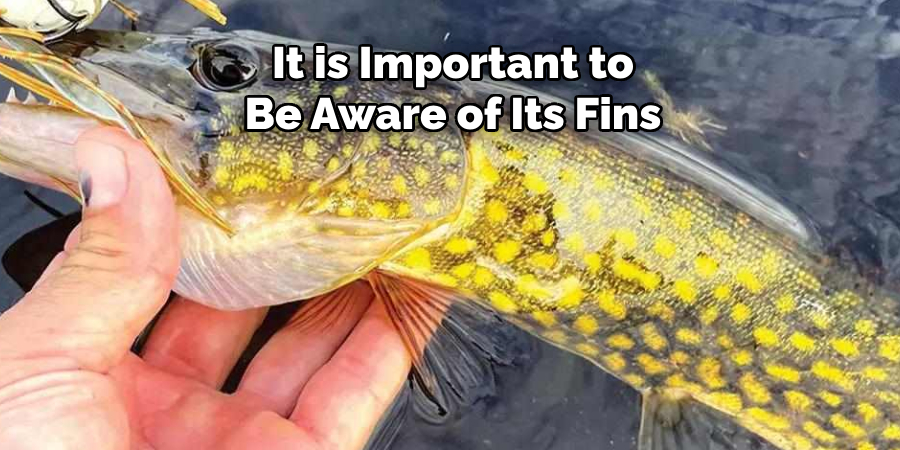
5. Use Wet Hands or Gloves:
Wet your hands before handling pickerel to reduce stress and protect their slime coat. Alternatively, wear gloves to provide better grip and protection from the fish’s teeth. Wet hands or gloves also help prevent the pickerel’s scales from drying out, which can lead to injury.
Additionally, wet hands or gloves can also help prevent the transfer of harmful bacteria from your hands to the fish. This is especially important if you have any cuts or open wounds on your hands. It’s always better to be safe than sorry when it comes to handling wild animals.
When choosing gloves, make sure they are made specifically for fishing or water sports. These types of gloves are usually made with a non-slip material that provides better grip. Avoid using thick or bulky gloves as they can make it difficult to handle the fish properly.
6. Be Prepared for the Pickerel’s Thrashing:
Pickerel are known for their aggressive behavior and vigorous thrashing when caught. Be prepared for sudden movements and try to anticipate the fish’s actions to avoid injury to yourself or damage to the fish. Though not typically dangerous, pickerel can have sharp teeth and spiny fins so it’s important to handle them with care. When preparing to catch pickerel, make sure you have the proper equipment and knowledge to handle their thrashing behavior.
7. Use a Landing Net for Larger Pickerel:
For larger pickerel, consider using a landing net to bring the fish to shore or boat. A landing net helps control the fish and reduces the risk of injury during landing. Choose a net with a soft mesh to prevent damage to the fish’s fins and scales. Additionally, make sure the handle is long enough to reach the water without leaning over too far.
It’s important to properly use a landing net when catching larger pickerel. Start by holding the handle of the net with one hand and extend your arm towards the fish in the water. Once you are close enough, gently scoop up the fish with the net, being careful not to apply too much pressure.
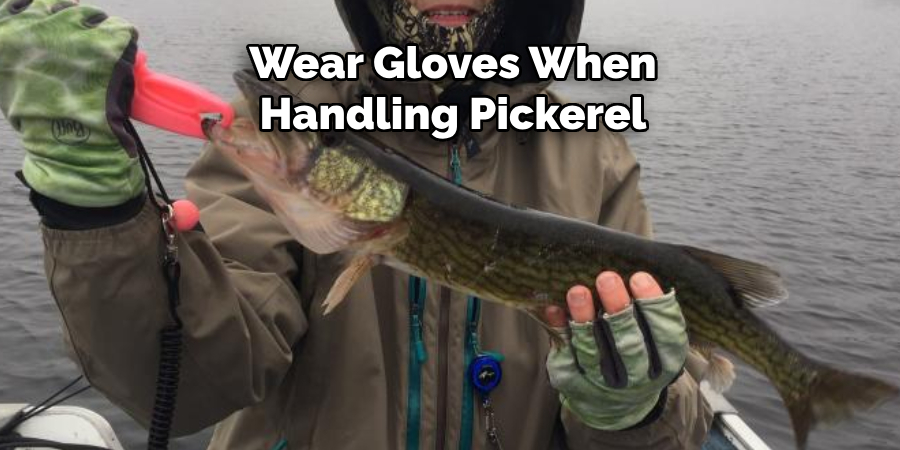
8. Be Gentle During Hook Removal:
When removing the hook from a pickerel, be gentle and patient to minimize stress and injury. Use pliers or forceps to carefully remove the hook, taking care not to damage the fish’s mouth or throat. If the hook is deeply embedded, consider cutting the line rather than attempting to remove it. This will allow the fish to move freely and have a better chance of survival. When using treble hooks, always remove them one at a time to reduce the risk of injury and ensure that none are left behind.
9. Practice Catch and Release Responsibly:
If practicing catch and release, handle pickerel quickly and avoid keeping them out of the water for extended periods. Hold the fish horizontally in the water and allow it to revive before releasing it. Avoid handling pickerel with dry hands or rough surfaces, as this can remove their protective slime coat and increase their susceptibility to infections. It is also important to use barbless hooks whenever possible, as they greatly reduce the amount of stress and injury inflicted on the fish.
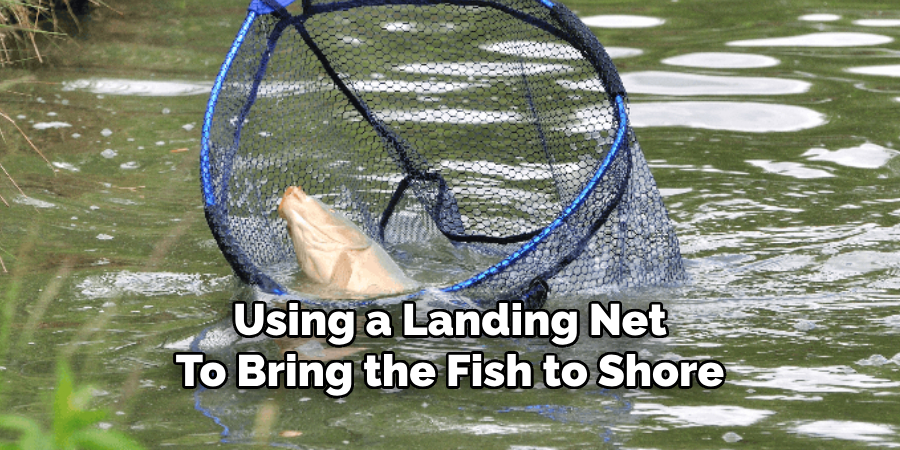
When it comes to releasing pickerel, there are a few additional steps you can take to ensure their survival. First, try not to exhaust the fish too much by reeling it in too quickly or fighting it for an extended period of time. This can deplete their energy reserves and make it harder for them to recover once released.
Once you have the fish close enough, use a landing net to gently scoop it up and avoid touching the fish with your hands as much as possible. If you do need to handle the fish, be sure to wet your hands first and support its body properly.
10. Educate Yourself on Local Regulations:
Before targeting pickerel, familiarize yourself with local fishing regulations and conservation measures. Some areas have specific rules regarding pickerel fishing, including size and bag limits, as well as seasonal closures.
By following these regulations, you can help ensure the sustainability of pickerel populations for future generations of anglers to enjoy. Additionally, it’s important to respect catch-and-release practices when fishing for pickerel. These fish are known for their sporty fight and can be a thrill to catch, but they should always be released back into the water unharmed. This helps maintain the balance of the ecosystem and allows for more opportunities to catch pickerel in the future.
In addition to regulations, it’s also important to educate yourself on the specific habitats and behaviors of pickerel. These fish are commonly found in shallow, weedy areas of lakes, ponds, and slow-moving rivers. They are aggressive ambush predators, often lurking near cover such as fallen trees, weed beds, and rock formations. Understanding their preferred habitats and feeding patterns can greatly increase your chances of a successful catch.
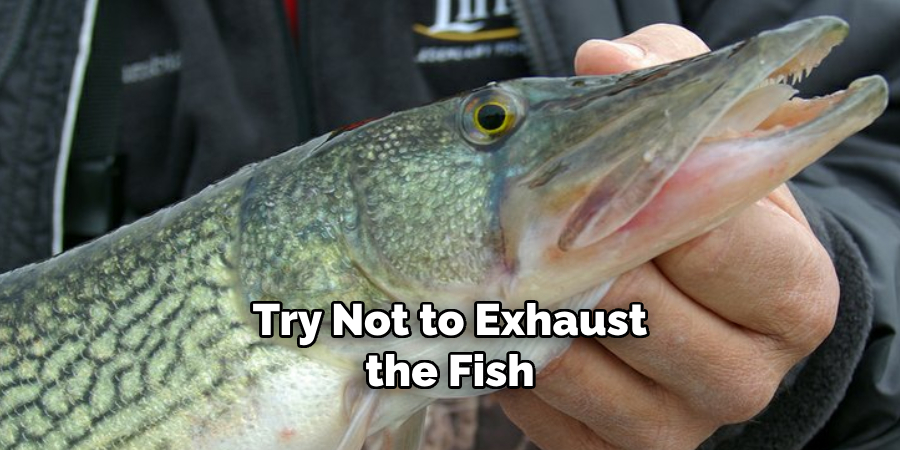
Conclusion
In conclusion, mastering the art of holding a pickerel properly is essential for the well-being of both the fish and the angler. By understanding the anatomy of pickerel and employing the proper holding techniques outlined in this guide, anglers can minimize stress on the fish and reduce the risk of injury to themselves.
Whether using the classic grip method, fishing gloves, or alternative techniques for larger pickerel, prioritizing safe handling practices ensures a successful catch-and-release experience. Responsible fishing includes being prepared with the right tools and equipment, assessing the fish’s condition post-catch, and releasing it gently back into the water. Thanks for reading, and we hope this has given you some inspiration on how to hold a pickerel!
About the Author
Jennifer Branett is the author of Fishy Kayak and an expert in fish-related fields, with over 10 years of experience. Her work blends passion for fishing with a commitment to conservation.
Educational Background
Degree: Bachelor’s in Marine Biology
Institution: University of California, Santa Barbara
Specializations: Aquatic ecosystems, fish behavior, and sustainable practices
Professional Experience
Conservation Projects:
Collaborated with local organizations to restore aquatic habitats
Developed educational programs on sustainable fishing practices
Publications:
Authored articles for fishing magazines and environmental journals
Featured speaker at fishing expos and conservation conferences
Key Areas of Expertise
Fishing Techniques:
Kayak fishing strategies
Freshwater and saltwater fishing methods
Environmental Stewardship:
Advocacy for sustainable fishing
Promoting biodiversity in aquatic environments
Awards and Recognition
Recipient of the [Specific Award Name] for contributions to marine conservation
Recognized as a leading voice in the fishing community by [Organization/Publication Name]
Community Engagement
Workshops and Seminars:
Regularly hosts events to educate anglers on sustainable practices
Engages with youth programs to inspire the next generation of fishers
Online Presence:
Maintains an active blog sharing tips, stories, and conservation efforts
Engages with followers on social media to promote fishing ethics
Personal Interests
Enjoys kayaking in scenic locations
Passionate about photography, capturing the beauty of nature
Advocates for local conservation efforts in her community
